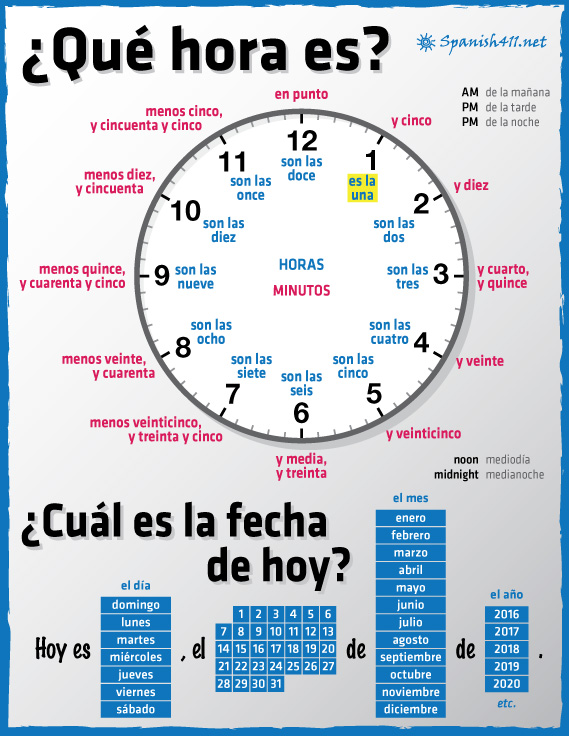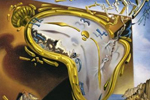|
||||||||||||||||||||||||||||||||||||||||||||||||||||||||||||||||||||||||||||||||||||||||||||||||||||||||||||||||||||||||||||||||||||||||||||||||||||||||||||||||||||||||||||||||||||||
 |
||||||||||||||||||||||||||||||||||||||||||||||||||||||||||||||||||||||||||||||||||||||||||||||||||||||||||||||||||||||||||||||||||||||||||||||||||||||||||||||||||||||||||||||||||||||
 |
||||||||||||||||||||||||||||||||||||||||||||||||||||||||||||||||||||||||||||||||||||||||||||||||||||||||||||||||||||||||||||||||||||||||||||||||||||||||||||||||||||||||||||||||||||||
Times and Dates in Spanish
Telling Time in SpanishTo ask someone what time it is in Spanish, say this: ¿Qué hora es? To tell someone what time it is use this formula: son + las + the hour Note: It’s also acceptable to write times in numerical format in Spanish Think of it as telling someone how many hours there are (or have been) since 12:00. For example: Son las siete. Son las once. One major exception occurs at 1:00. Since there is only one hour, switch to a singular verb and article: Es la una. To indicate that the time is exactly on the hour, include en punto (“on the dot”): Es la una en punto. Son las siete en punto. To express time past the top of the hour use y and the number of minutes: Es la una y cinco. Son las dos y diez. Note: Don’t confuse cuatro (four) with cuarto (quarter). To express quarter hours you can use either quince or cuarto (quarter): Es la una y quince. Son las tres y cuarto. To express half hours you can use either treinta or media (half): Es la una y treinta. Son las cuatro y media. For times greater than a half hour you can either add the appropriate number of minutes or skip ahead to the next hour and subtract: Es la una y cuarenta. Son las dos menos veinte. Times past the half hour may also be expressed using para and/or faltar (to lack) like this: Faltan diez para las dos. Son diez para las siete. Times in Other TensesNote: Use the imperfect tense when stating times in the past. You are not limited to the present when talking about time: Era la una de la mañana. En dos horas serán las once. Other Useful Time Expressions in SpanishNote: AM stands for Ante Meridiem (“before midday” in Latin). PM stands for Post Meridiem (“after midday” in Latin). Most Spanish speakers do not use “AM” or “PM.” To specify the period of the day you should add de la mañana (in the morning), de la tarde (in the afternoon), or de la noche (in the evening): Es la una de la mañana. Son las tres de la tarde. Son las nueve de la noche. For more information: Many digital clocks and printed schedules in Spanish speaking countries use a 24-hour time format for simplicity:
Use mediodía to say “noon.” Use medianoche to say “midnight”: Es mediodía. Es medianoche. To ask when something will occur, use a que hora or cuándo: ¿A qué hora sale el avión? ¿Cuándo viene Roberto? To state when something will occur, use a las or a la: El avión sale a las dos y media. Roberto viene a la una. Dates in SpanishNote: Spanish days and months are all masculine. Note: Setiembre (abbreviated “set”) is also considered a valid spelling in some places. Note: Some Spanish speaking countries use single letter abbreviations for days of the week: Note: In some Spanish speaking countries, Monday (lunes) is considered the first day of the week. Month Names and Day NamesBefore we begin, here’s a quick review of month names and day names (as well as their abbreviations):
Notice that neither day names nor month names are capitalized in Spanish. To ask someone what the date is in Spanish, say this: ¿Cuál es la fecha de hoy? The following questions will also work: ¿Qué día es hoy? To tell someone the date in Spanish, use this formula. el + number + de + month + de + year Note: You may also see dates abbreviated this way: Notice there is a major difference between America and the Spanish-speaking world when formatting dates. In Spanish, the day comes first, followed by the month, and then the year (this is true of other English-speaking countries as well):
There is no need for using a comma with Spanish dates. Note: When working with dates, Spanish numbers are masculine. You may also spell out numbers when writing: el cuatro de julio de 1776 One irregularity to be aware of happens with the first of the month. Rather than saying el uno, we use an ordinal number instead, el primero:
This is only true for the first of the month. Don’t turn May 5 into quinto de mayo; it’s cinco de mayo. Note: In some places you may even see month numbers written in Roman numerals: 7 / XII / 2020 or When you see dates written in numbers only, remember that in Spanish, the day comes first and then the month (or you may find yourself missing some important events):
See also: Numbers in Spanish ¡Ojo!When saying dates in Spanish you may not break the year into two parts as we do in English; the year is treated as one large number:
To include the name of the day, place it in front of the date and add a comma: Hoy es jueves, el 25 de diciembre de 2025. Other Useful Date Expressions in SpanishNote: Anno Domini is Latin for “the Year of Our Lord.” In English, dates occasionally include “B.C.” (Before Christ) or “A.D.”(Anno Domini) to reckon the number of years before or since the birth of Jesus Christ. The more politically correct terms are “BCE” (Before the Common Era) and “CE” (Common Era). In Spanish they look like this:
To say “in a certain month” use the preposition en: Voy a Guatemala en abril. To say “on a certain day” use the definite article el: Me voy el lunes. Me voy el tres de abril. Notes on Times and Dates in SpanishOf the 22 Spanish-speaking countries in the world, only the U.S., Spain, Chile, and Uruguay participate in Daylight Savings Time. To a North American it may seem that Hispanics have a very relaxed view of times and deadlines. While airline, train, and TV schedules tend to be punctual, informal gatherings may not actually begin until an hour or more after the agreed upon time. A meeting scheduled for 6:00 may not get started until 7:30. If a Spanish speaker asks to meet with you a las siete, it may be more accurate to think that you’ve been asked to come no earlier than 7:00. Sometimes the word mañana may be better translated as “not today.” More Useful Words for Times and Dates in Spanish
|
||||||||||||||||||||||||||||||||||||||||||||||||||||||||||||||||||||||||||||||||||||||||||||||||||||||||||||||||||||||||||||||||||||||||||||||||||||||||||||||||||||||||||||||||||||||
 This work by Spanish411.net is licensed under a Creative Commons Attribution-NonCommercial-ShareAlike 4.0 International License. This work by Spanish411.net is licensed under a Creative Commons Attribution-NonCommercial-ShareAlike 4.0 International License. |
||||||||||||||||||||||||||||||||||||||||||||||||||||||||||||||||||||||||||||||||||||||||||||||||||||||||||||||||||||||||||||||||||||||||||||||||||||||||||||||||||||||||||||||||||||||



